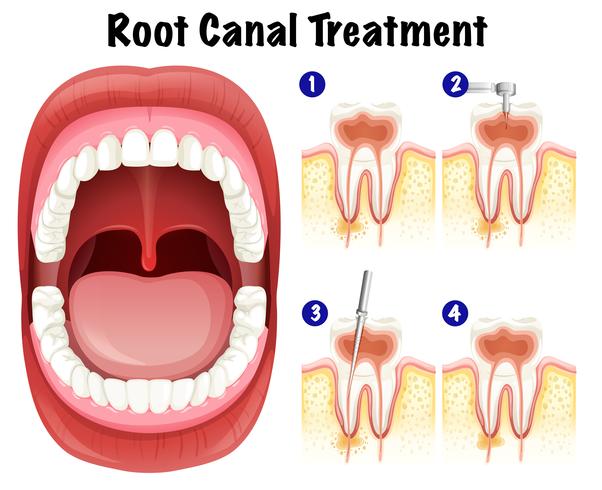HEALTH
An In-Depth Look at the Root Canal Procedure

Have you ever wondered what is a root canal and what it entails? Dentists commonly perform this procedure to help restore health to a damaged tooth, but many are unaware of what exactly happens during the process. In this article, let’s take an in-depth look at the root canal procedure to help you understand what is root canal treatments, why it’s necessary, and how it works.
What is a Root Canal?
A root canal involves removing infected, injured or dead pulp tissue from inside the root canals of a tooth to preserve the decayed tooth and prevent further damage to the surrounding teeth and gums. The earlier a root canal is performed, the more successful it will be in treating the underlying issues. A root canal-treated tooth can last years with prompt treatment and proper care.
Benefits of Getting a Root Canal Treatment
Relief of Pain
A root canal can eliminate dental pain and restore your teeth’s function. Removing the infection, you can experience quick relief from toothaches caused by decay or trauma.
Preservation of Your Tooth
Getting a root canal saves your tooth structure and keeps the tooth in its place. If the infection is not treated, you may end up needing to have a tooth extraction. A root canal helps to maintain the natural appearance of your teeth by preserving them for longer.
Reduced Risk of Further Infection
Root canals seal off potential areas where bacteria or other infection-causing agents can enter to reduce the risk of further infection and prevent further damage to your teeth or gums.
Improved Oral Health
Getting root canal treatment is important to maintaining good oral hygiene and overall health. By eliminating the source of infection, you can reduce bad breath, gum disease, and other oral health complications.
Root Canal Treatment to Save Your Tooth!

What happens during root canal treatment? Here is the process:
Anaesthesia and isolation
Before starting the procedure, a local anaesthetic is administered to numb the affected area. The dentist will also use a rubber dam to isolate the tooth from other teeth and saliva.
Drilling and access to the pulp
The dentist can access the pulp chamber and root canals by drilling through the top of the tooth.
Removal of the pulp
The dentist removes the tooth’s infected or damaged pulp using special instruments such as files and reamers.
Cleaning and shaping of the canals
The dentist then cleans and shapes the canals using files, irrigation solutions, and other instruments. This process helps ensure the root canals are clear of bacteria and debris.
Filling the canals
The root canals are then filled with an inert material such as gutta-percha. A sealer may also be used to help ensure a tight fit.
Placing a crown
The dentist will take a tooth’s impression and send it to a laboratory for fabrication. The crown is then cemented into place over the tooth. It helps to protect and strengthen the remaining structure of the tooth.
When Do You Need a Root Canal?
Your dentist may suggest root canal therapy if you’re experiencing any of the following symptoms:
- Severe tooth pain upon biting down or chewing, especially when it lingers beyond an initial few seconds
- Sensitivity to hot and cold temperatures in the affected area of your mouth
- Swelling, tenderness or discolouration in the area of the affected tooth
- Persistent pimple-like bumps on your gums
Potential Risks Involved in Root Canal
Root canal treatment is usually a safe and straightforward procedure, but there are some potential risks associated with the process. Infection can occur during or after the procedure if not performed properly or if bacterial contamination happens during treatment. In addition, root canal therapy may cause damage to adjacent teeth or other structures near the tooth’s root, such as the sinus or the inferior alveolar nerve. If the pulp is not fully removed during treatment, it may cause recontamination of the root canal system and lead to reinfection or even an abscess.
How Can You Prevent the Need for a Root Canal?
Proper brushing and flossing habits can help protect teeth from decay that will lead to infection. Regular visits to the dentist will allow them to diagnose any potential issues before they become too severe, eliminating the need for more invasive procedures such as root canals.
Other preventive measures include:
- Limiting sugary and acidic foods and drinks.
- Using an antibacterial rinse to help protect against bacteria.
- Wearing a mouthguard when playing sports or grinding teeth at night.
While these practices cannot guarantee that you’ll never need a root canal, they can significantly reduce your risk of needing one.
In Summary
Taking a root canal may cause some discomfort, but it is essential to help restore the overall health of your tooth. Although the process sounds pretty intimidating, a good dentist will keep you comfortable throughout, ultimately leading to greater dental health for years to come. Visit your local dentist immediately if you are experiencing any signs of tooth decay or sensitivity, so they can diagnose you and recommend the most appropriate form of treatment. Your teeth remain healthy and strong for many years with proper care and attention.
Kenneth is a proud native of sydney, born and raised there. However, he pursued his education abroad and studied in Australia. Kenneth has worked as a journalist for almost a decade, making valuable contributions to prominent publications such as Yahoo News and The Verge. Currently, he serves as a journalist for The Hear Up, where he focuses on covering climate and science news. You can reach Kenneth at [email protected].










